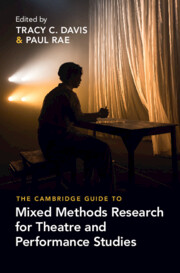Book contents
- The Cambridge Guide to Mixed Methods Research for Theatre and Performance Studies
- Reviews
- The Cambridge Guide to Mixed Methods Research for Theatre and Performance Studies
- Copyright page
- Contents
- Figures
- Tables
- Contributors
- Acknowledgements
- Introduction:
- Part I Planning
- Part II Doing
- Chapter 6 You’re Already a Digital Humanist:
- Chapter 7 Analysing Immersive Performance through Lived Bricolage
- Chapter 8 Talking Theatre in an Oral Culture:
- Chapter 9 Painful Fieldwork?
- Chapter 10 Fieldwork as Method in Theatre and Performance Studies
- Part III Interpreting
- Index
- References
Chapter 10 - Fieldwork as Method in Theatre and Performance Studies
from Part II - Doing
Published online by Cambridge University Press: 01 February 2024
- The Cambridge Guide to Mixed Methods Research for Theatre and Performance Studies
- Reviews
- The Cambridge Guide to Mixed Methods Research for Theatre and Performance Studies
- Copyright page
- Contents
- Figures
- Tables
- Contributors
- Acknowledgements
- Introduction:
- Part I Planning
- Part II Doing
- Chapter 6 You’re Already a Digital Humanist:
- Chapter 7 Analysing Immersive Performance through Lived Bricolage
- Chapter 8 Talking Theatre in an Oral Culture:
- Chapter 9 Painful Fieldwork?
- Chapter 10 Fieldwork as Method in Theatre and Performance Studies
- Part III Interpreting
- Index
- References
Summary
This contribution addresses fieldwork as an anthropological method. It discusses the surprising lack of a systematic conversation between anthropology and performance as well as theatre research since the ‘performative turn’. Seeking to clarify terminological distinctions between ethnography, fieldwork, and method, Jonas Tinius draws upon his fieldwork with a theatre in the western German Ruhr region to discusses how a complex understanding of the field and the commitments we make to fieldwork may offer possibilities for working across anthropology, performance, and theatre. It concludes with a sketch of three practical ways to think about the mixing of anthropological methods in performance research.
- Type
- Chapter
- Information
- Publisher: Cambridge University PressPrint publication year: 2024



